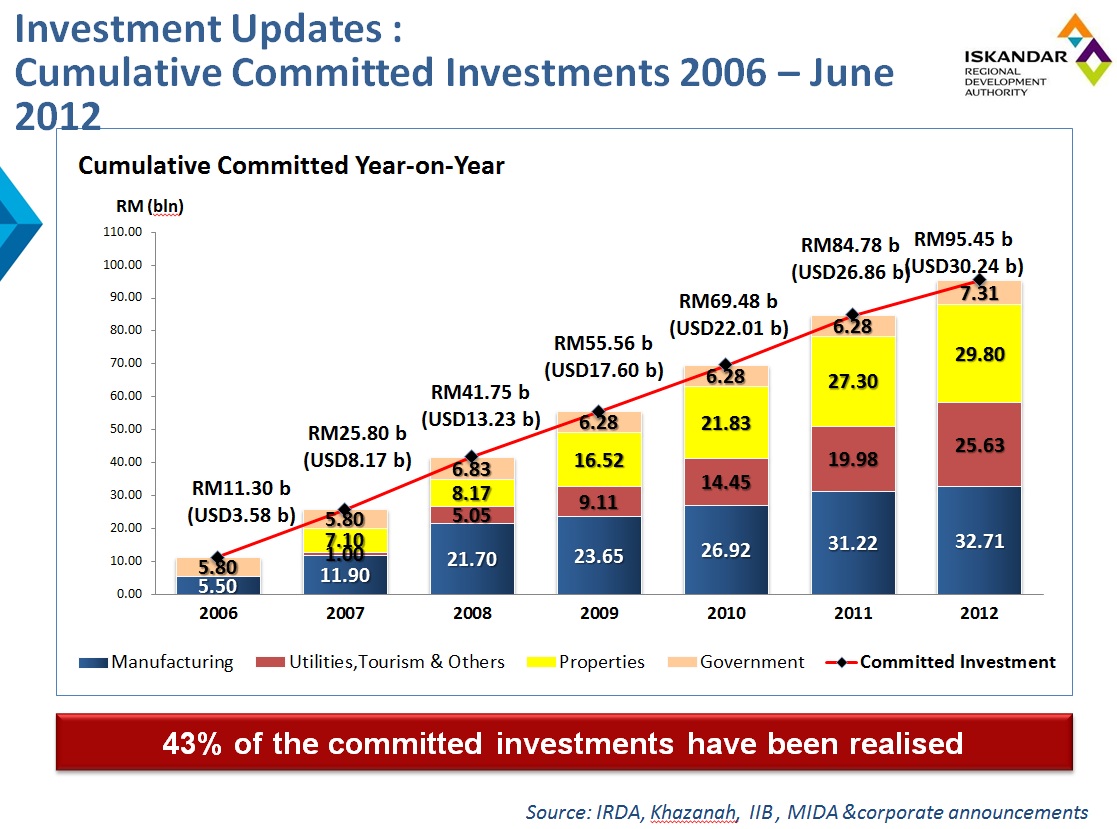Iskandar likely to cross RM100bil investment mark by year end
By Karamjit Singh September 4, 2012
- Domestic investments make up 68% with FDI at 32%
- Overall development guided by Comprehensive Development Plan
THE momentum that the Iskandar Malaysia development hub is experiencing can be seen in the numbers: From an average investment of between RM8 billion and RM10 billion from 2006 to 2009, rising to between RM12 billion and RM15 billion in 2010-2011, this year will see the committed investment hit RM20 billion says an excited Datuk Ismail Ibrahim, chief executive officer of the Iskandar Regional Development Authority or IRDA.
[RM1 = US$0.32]
“We feel we have the capacity and strength to hit this, especially with … several catalytic projects [Legoland Park, EduCity, Pinewood Studios] already in place or about to be launched. These will create the right multiplier effect,” he says optimistically.
 Behind the total investment figure as of end June of RM95.45 billion (US$30.24 billion) lies another story Ismail is happy to share. There has been a sure shift in the past few years from the investments being FDI (foreign direct investment) in nature to now being more DDI (domestic direct investment) in nature, which creates a greater multiplier effect.
Behind the total investment figure as of end June of RM95.45 billion (US$30.24 billion) lies another story Ismail is happy to share. There has been a sure shift in the past few years from the investments being FDI (foreign direct investment) in nature to now being more DDI (domestic direct investment) in nature, which creates a greater multiplier effect.
“It used to be that FDI made up 55% to 45% … but today, six years down the road, there is a total flip with DDI at 68% and FDI at 32%,” he says [click chart to enlarge].
This does not diminish the value of FDI however. For example, global consulting and market research firm Frost & Sullivan coming in to establish what will eventually be its largest Global Innovation Center (GIC) operations in the world with RM550 million (US$176 million) invested by 2020 sends a strong message of confidence to other players.
“When you have a global company offering professional services coming in early here, you can expect other professional services firms to come in and provide healthy competition to Frost too,” says Ismail.
Ismail, who was part of the team in Khazanah Nasional – the Malaysian Government’s investment arm – that spearheaded the planning of Iskandar back in 2005, reveals that 14 consultant firms were involved in coming up the various plans that were later consolidated into a Comprehensive Development Plan which really lays out the vision for the region.
“For instance, from Day One we had a Human Capital Development blueprint which lays out in simple terms the supply and demand scenario of the various economic type activities at Iskandar to the 2025 time -frame of the project.”
What this does is to help IRDA and the various authorities to anticipate the demand that will be coming in and work proactively to meet the demand with the suitable supply. This goes beyond relying on just the talent pool coming out from University Teknologi Malaysia’s (UTM) Skudai campus which has a focus on engineering.
What role does technology play in the planning of Iskandar? According to Ismail, the use of technology is part of the package to ensure those who live and work in Iskandar enjoy the best facilities and infrastructure available.
“We are trying to think of what will be used in the future and are bringing it here now to be implemented and there are several initiatives, all underpinned by our ICT (Information and Communication Technology) blueprint which guides the way we should be growing.”
IRDA is also in constant discussions with various ICT agencies such as the Multimedia Development Corporation (MDeC), Mampu (Malaysian Administrative Modernization and Management Planning Unit) and also the Johor State Government to ensure that the ICT plans are carried out.
“I just had a discussion recently with Telekom Malaysia Bhd and they are progressing well in readying broadband infrastructure and other forms of services for Iskandar,” Ismail adds.
Basically, IRDA is collaborating with all parties to ensure the ecosystem and environment offered at Iskandar will be the most attractive available. “We are benchmarking with best practices globally to ensure what we deliver, be it in the form of ICT or any other infrastructure and services, is the most current and best that is available,” says Ismail.
Related Stories:
Bio-XCell taking shape in Iskandar
Frost & Sullivan’s game changer bet on Iskandar Malaysia


